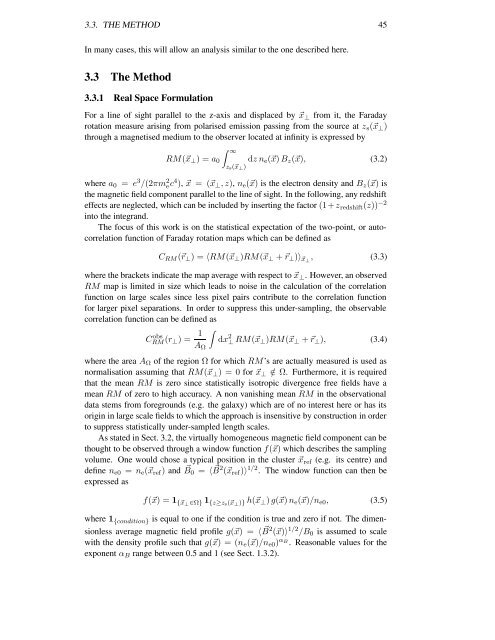Investigations of Faraday Rotation Maps of Extended Radio Sources ...
Investigations of Faraday Rotation Maps of Extended Radio Sources ...
Investigations of Faraday Rotation Maps of Extended Radio Sources ...
Create successful ePaper yourself
Turn your PDF publications into a flip-book with our unique Google optimized e-Paper software.
3.3. THE METHOD 45<br />
In many cases, this will allow an analysis similar to the one described here.<br />
3.3 The Method<br />
3.3.1 Real Space Formulation<br />
For a line <strong>of</strong> sight parallel to the z-axis and displaced by ⃗x ⊥ from it, the <strong>Faraday</strong><br />
rotation measure arising from polarised emission passing from the source at z s (⃗x ⊥ )<br />
through a magnetised medium to the observer located at infinity is expressed by<br />
RM(⃗x ⊥ ) = a 0<br />
∫ ∞<br />
z s(⃗x ⊥ )<br />
dz n e (⃗x) B z (⃗x), (3.2)<br />
where a 0 = e 3 /(2πm 2 e c4 ), ⃗x = (⃗x ⊥ , z), n e (⃗x) is the electron density and B z (⃗x) is<br />
the magnetic field component parallel to the line <strong>of</strong> sight. In the following, any redshift<br />
effects are neglected, which can be included by inserting the factor (1+z redshift (z)) −2<br />
into the integrand.<br />
The focus <strong>of</strong> this work is on the statistical expectation <strong>of</strong> the two-point, or autocorrelation<br />
function <strong>of</strong> <strong>Faraday</strong> rotation maps which can be defined as<br />
C RM (⃗r ⊥ ) = 〈RM(⃗x ⊥ )RM(⃗x ⊥ + ⃗r ⊥ )〉 ⃗x⊥ , (3.3)<br />
where the brackets indicate the map average with respect to ⃗x ⊥ . However, an observed<br />
RM map is limited in size which leads to noise in the calculation <strong>of</strong> the correlation<br />
function on large scales since less pixel pairs contribute to the correlation function<br />
for larger pixel separations. In order to suppress this under-sampling, the observable<br />
correlation function can be defined as<br />
CRM(r obs ⊥ ) = 1 ∫<br />
dx 2 ⊥ RM(⃗x ⊥ )RM(⃗x ⊥ + ⃗r ⊥ ), (3.4)<br />
A Ω<br />
where the area A Ω <strong>of</strong> the region Ω for which RM’s are actually measured is used as<br />
normalisation assuming that RM(⃗x ⊥ ) = 0 for ⃗x ⊥ /∈ Ω. Furthermore, it is required<br />
that the mean RM is zero since statistically isotropic divergence free fields have a<br />
mean RM <strong>of</strong> zero to high accuracy. A non vanishing mean RM in the observational<br />
data stems from foregrounds (e.g. the galaxy) which are <strong>of</strong> no interest here or has its<br />
origin in large scale fields to which the approach is insensitive by construction in order<br />
to suppress statistically under-sampled length scales.<br />
As stated in Sect. 3.2, the virtually homogeneous magnetic field component can be<br />
thought to be observed through a window function f(⃗x) which describes the sampling<br />
volume. One would chose a typical position in the cluster ⃗x ref (e.g. its centre) and<br />
define n e0 = n e (⃗x ref ) and B ⃗ 0 = 〈 B ⃗ 2 (⃗x ref )〉 1/2 . The window function can then be<br />
expressed as<br />
f(⃗x) = 1 {⃗x⊥ ∈Ω} 1 {z≥zs(⃗x ⊥ )} h(⃗x ⊥ ) g(⃗x) n e (⃗x)/n e0 , (3.5)<br />
where 1 {condition} is equal to one if the condition is true and zero if not. The dimensionless<br />
average magnetic field pr<strong>of</strong>ile g(⃗x) = 〈 ⃗ B 2 (⃗x)〉 1/2 /B 0 is assumed to scale<br />
with the density pr<strong>of</strong>ile such that g(⃗x) = (n e (⃗x)/n e0 ) α B<br />
. Reasonable values for the<br />
exponent α B range between 0.5 and 1 (see Sect. 1.3.2).
















